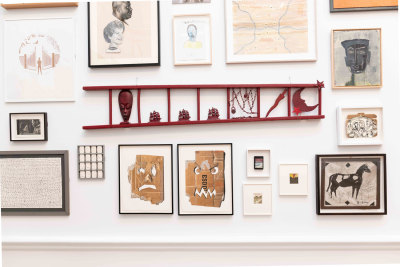Book extract: Anthony Whishaw RA is celebrated in a new monograph
Book extract: Anthony Whishaw RA is celebrated in a new monograph
By Richard Davey
Published 3 June 2016
Richard Davey celebrates the independent spirit that characterises Anthony Whishaw RA’s paintings in this extract from a new monograph.
-
From the Summer 2016 issue of RA Magazine, issued quarterly to Friends of the RA.
Every April since his election to the Royal Academy in 1980 Anthony Whishaw has stood in his studio, surrounded by his paintings, and finalised his selection of the works he will be submitting for the year’s Summer Exhibition. April 2015 was no different. In November 2014 Whishaw had already decided on Come Dance with Me (2013-2015; pictured), a three-metre-long canvas he had been working on since 2013. Now, with just a month to go before the submission deadline, he had to decide on the others. With every Royal Academician allowed to submit up to six pieces he could have entered another five, but in the end he selected just three more.
The four paintings Whishaw chose challenged the modernist narrative of linear progression, in which artists focus on one defined series of work at a time, and in which one idea flows neatly into the next, always looking forward rather than back. Whishaw doesn’t work in this way. The walls of his Kensington studio are covered with paintings that use a variety of visual languages and explore a range of subjects. Paintings of trees and Mediterranean seascapes, abstract colour fields and chiaroscuro still-lifes jostle for attention with no sense of hierarchy or obvious evolution. Whishaw started some of the paintings here 30 years ago, yet he is still adding to and altering them. On their reverse can be seen crossed-out dates that record a lifetime of continued reflection in which nothing is finished until it actually leaves the studio and is no longer in his possession.
The Royal Academy’s Summer Exhibition also challenges the modernist narrative by offering a visual miscellany of paintings, prints and photographs that vie for the viewer’s attention, with abstract works hung next to more traditional figurative works, still-lifes next to portraits, landscapes next to architectural drawings, just as in Whishaw’s studio. In 2015 Come Dance with Me was hung high on the south wall of the RA’s largest gallery surrounded by the work of his fellow Royal Academicians. This large, abstract painting is a celebration of line and colour, its ribbons of pink, red, turquoise and blue weaving sinuous patterns around the picture surface to suggest a series of joyful, dancing rhythms. Nearby was St Paul’s Multiview II (2009–10), a painting that combines elements of cubism and abstraction, collage, realism and topographical architectural drawing. The composition’s fractured space sends the viewer’s gaze ricocheting around multiple viewpoints, sometimes sliding off steeply angled geometric planes of colour, sometimes being drawn into distant views of Wren’s iconic dome.
-

Anthony Whishaw RA, Flying Above II, 2011-2015.
-
Whishaw’s two other paintings hung amid the dense grouping of small works in another gallery. Like his depiction of St Paul’s, Flying Above II (2011–15; pictured) has an architectural focus. As we look down on the rooftops of a Spanish hilltop pueblo, the towers of a church rise out of a blue-and-green mist, with roofs and chimneys tumbling around them in a cubist cascade of multiple viewpoints. Some of these architectural features are painted with a hard-edged clarity while others are left as mere suggestions, half-glimpsed through the fog. Mirrored Flowers (1998–2005) employs multiple viewpoints too, but that is where the visual similarity ends. Using elements of both abstraction and figuration to create a fantastical Escher-like composition, the work contains conventional landscape elements, with hints of sea and sky, fields and fences, flowers and stars. Yet it is also a fantasy, with two horizon lines, multiple perspectives, and two dark curving lines that evoke the mirror of the title, pulling the viewer, Alice-like, through the surface into a tilting, twisting pictorial space that is at once rational and incoherent.
For those wanting to pigeonhole artists into schools or ‘-isms’, Whishaw’s eclecticism can be frustrating. His paintings defy classification. Despite being a Royal Academician, and exhibiting widely in group shows with other major British artists, he has never been one to follow trends, or to align himself with a particular stylistic group. He resists art-historical categorisation or contextualisation, pursuing his own unique path and commitment to his materials. One moment he is exploring cubist constructions of space, the next, trompe-l’oeil playfulness. His use of photocopies and collage, and his application of plastic cups, plastic flies and other objects to his picture surfaces, suggest that he is someone with contemporary concerns and an interest in experimentation. And yet his subjects are often traditional or come from his everyday experience, focusing on architectural details and picturesque scenes reminiscent of the 19th or early 20th centuries. His disregard for stylistic boundaries and subject hierarchies has all the hallmarks of postmodernism, and yet Whishaw’s art is without the knowingness and parody of much contemporary work.
The four pieces Whishaw submitted to the Summer Exhibition in 2015 had so little in common in terms of style or content that they could easily have been mistaken for the work of four different artists. But it is this very commitment to diversity rather than uniformity, and a refusal to be defined and restricted by labels, that unites Whishaw’s prolific output. Even in his 80s he still wants to explore the boundaries of paint, and to push its ability to inspire, delight, evoke memories, shock and excite, as he has always done – not by focusing in and narrowing down his work into an identifiable visual signature, but by constantly trying new things, hoping to be surprised and intrigued by what might emerge.
Richard Davey is a writer and a visiting fellow at the School of Art and Design, Nottingham Trent University.
-
-
Enjoyed this article?
Become a Friend to receive RA Magazine
As well as free entry to all of our exhibitions, Friends of the RA enjoy one of Britain’s most respected art magazines, delivered directly to your door. Why not join the club?

-





